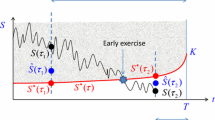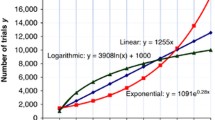Abstract
This paper presents the total least squares quasi-Monte Carlo approach (TLSQM) for valuing American barrier options, which modifies the least-squares Monte Carlo method (LSM). The total least squares are applied to estimate the conditional expected payoff to the option holder from continuation, and the quasi-Monte Carlo method is used to simulate the paths of stock prices. We show that the approximations of a set of conditional expectation functions in the TLSQM method converge to the true expectation function under general assumptions. It provides the mathematical foundation for the use of the TLSQM method in the derivatives research. In order to illustrate the high efficiency of the proposed approach, several examples are given to price American barrier options using TLSQM, LSM, and binomial trees, respectively. The numerical analysis demonstrates that the TLSQM method is accurate, and it makes improvements in computational speed and efficiency, compared with the LSM method.

Similar content being viewed by others
References
Beasley, J. D., & Springer, S. G. (1977). Algorithm As 111: The percentage points of the normal distribution. Applied Statistics, 26(1), 118–121.
Boyle, P., & Lau, S. (1994). Bumping up against the barrier with the binomial method. Journal of Derivatives, 1(4), 6–14.
Boyle, P., & Tian, Y. (1999). Pricing lookback and barrier options under the CEV process. Journal of Financial and Quantitative Analysis, 34(2), 241–264.
Broadie, M., Glasserman, P., & Kou, S. (1997). A continuity correction for discrete barrier options. Mathematical Finance, 7(4), 325–349.
Broadie, M., Glasserman, P., & Kou, S. (1999). Connecting discrete and continuous path-dependent options. Finance and Stochastics, 3(1), 55–82.
Chance, D. (1994). The pricing and hedging of limited exercise of caps and spreads. Journal of Financial Research, 17(4), 561–584.
Cheuk, T., & Vorst, T. (1996). Complex barrier options. Journal of Derivatives, 4(1), 8–22.
Cont, R., & Tankov, P. (2004). Nonparametric calibration of jump-diffusion option pricing models. Journal of Computational Finance, 7(3), 1–49.
Davydov, D., & Linetsky, V. (2001). Pricing and hedging path-dependent options under the CEV process. Management Science, 47(7), 949–965.
Figlewski, S., & Gao, B. (1999). The adaptive mesh model: A new approach to efficient option pricing. Journal of Financial Economics, 53(3), 313–353.
Gallo, P. (1982). Consistency of regression estimates when some variables are subject to error. Communications in Statistics-Theory and Methods, 11(9), 893–973.
Gaudenzi, M., & Lepellere, M. (2006). Pricing and hedging American barrier options by a modified bionmial method. International Journal of Theoretical and Applied Finance, 9(4), 533–553.
Gaudenzi, M., & Zanette, A. (2009). Pricing Ameican barrier options with discrete dividends by binomial trees. Decisions in Economics and Finance, 32(2), 129–148.
Golub, G., & VanLoan, C. (1980). An analysis of the total least squares problem. SIAM Journal on Numerical Analysis, 17(6), 883–893.
Heynen, C., & Kat, H. (1994). Partial barrier options. Journal of Financial Engineering, 3(3), 253–274.
Joy, C., Boyle, P., & Tan, K. (1996). Quasi-Monte Carlo methods in numerical finance. Management Science, 42(6), 926–938.
Lo, C., Tang, H., Ku, K., & Hui, C. (2009). Valuing time-dependent CEV barrier options. Journal of Applied Mathematics and Decision Sciences, 2009, 1–17.
Longstaff, F., & Schwartz, E. (2001). Valuing American options by simulations: A simple least-squares approach. Review of Financial Studies, 14(1), 113–147.
Merton, R. (1973). Theory of rational option pricing. Bell Journal of Economics and Management Science, 4(1), 141–183.
Merton, R. (1976). Option pricing when underlying stock returns are discontinuous. Journal of Financial Economics, 3(1–2), 125–144.
Newey, K. (1997). Convergence rates and asymptotic normality for series estimators. Journal of Econometrics, 79(1), 147–168.
Petrella, G., & Kou, S. (2004). Numerical pricing of discrete barrier and lookback options via laplace transforms. Journal of Computational Finance, 8(1), 1–37.
Ritchken, P. (1995). On pricing barrier options. Journal of Derivatives, 3(2), 19–28.
Siven, J., Suchanecki, M., & Poulsen, R. (2009). Barrier options and lumpy dividends. Wilmott Journal, 1(3), 167–171.
Stentoft, L. (2004). Convergence of the least squares monte carlo approach to American option valuation. Management Science, 50(9), 1193–1203.
Xu, W. D., Wu, C. F., & Li, H. Y. (2011a). Foreign equity option pricing under stochastic volatility model with double jumps. Economic Modelling, 28(4), 1857–1863.
Xu, W. D., Wu, C. F., & Li, H. Y. (2011b). Accounting for the impact of higher order moments in foreign equity option pricing model. Economic Modelling, 28(4), 1726–1729.
Xu, W. D., Xu, W. J., Li, H. Y., & Xiao, W. L. (2012). A jump diffusion approach to modelling vulnerable option pricing. Finance Research Letters, 9(1), 48–56.
Acknowledgments
This work is supported by the National Natural Science Foundation of China (Nos. 70825005, 71171086), National Social Science Foundation of China (No. 11&ZD156) and New Century Excellent Talents in University (No. NCET-10-0401).
Author information
Authors and Affiliations
Corresponding author
Rights and permissions
About this article
Cite this article
Zhang, L., Zhang, W., Xu, W. et al. A Modified Least-Squares Simulation Approach to Value American Barrier Options. Comput Econ 44, 489–506 (2014). https://doi.org/10.1007/s10614-013-9409-4
Accepted:
Published:
Issue Date:
DOI: https://doi.org/10.1007/s10614-013-9409-4




